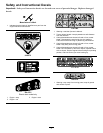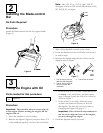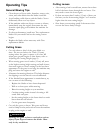
engine manufacturer in accordance with SAE J1940.
As congured to meet safety, emission, and operating
requirements, the actual engine horsepower on this class
of lawn mower will be signicantly lower.
Do not tamper with the engine controls or alter the
governor speed; doing so may create an unsafe condition
resulting in personal injury.
Safety
This machine meets or exceeds the CPSC blade safety
requirements for walk-behind rotary lawn mowers and
the B71.1 specications of the American National
Standards Institute in effect at the time of production.
Read and understand the contents of this manual
before you start the engine.
The safety alert symbol (
Figure 2) is used to alert you
to potential personal injury hazards. Obey all safety
messages that follow this symbol to avoid possible injury
or death. Improperly using or maintaining this machine
could result in injury or death. To reduce this potential,
comply with the following safety instructions.
The following instructions have been adapted from the
ANSI/OPEI standard B71.1-2003.
This cutting machine is capable of amputating
hands and feet and of throwing objects. Failure
to observe the following safety instructions could
result in serious injury or death.
General Operation
• Read, understand, and follow all instructions on the
machine and in the manual(s) before starting.
• Do not put hands or feet near or under the machine.
Keep clear of the discharge opening at all times.
• Only allow responsible adults, who are familiar with
the instructions, to operate the machine.
• Clear the area of objects such as rocks, wire, toys,
etc., which could be thrown by the blades. Stay
behind the handle when the engine is running.
• Be sure that the area is clear of bystanders before
operating. Stop the machine if anyone enters the
area.
• Do not operate the machine barefooted or while
wearing sandals. Always wear substantial footwear.
• Do not pull the machine backward unless it is
absolutely necessary. Always look down and behind
before and while moving backward.
• Never direct discharged material toward anyone.
Avoid discharging material against a wall or
obstruction. Material may ricochet back toward
the operator. Stop the blades when crossing gravel
surfaces.
• Do not operate the machine without the entire grass
catcher, discharge guard, rear guard, or other safety
protective devices in place and working.
• Never leave a running machine unattended.
• Stop the engine and wait until the blades come
to a complete stop before cleaning the machine,
removing the grass catcher, or unclogging the
discharge guard.
• Operate the machine only in daylight or good
articial light.
• Do not operate the machine while under the
inuence of alcohol or drugs.
• Never operate the machine in wet grass. Always be
sure of your footing. Walk, never run.
• Disengage the drive system, if so equipped, before
starting the engine.
• If the machine should start to vibrate abnormally,
stop the engine and check for the cause immediately.
Vibration is generally a warning of trouble.
• Always wear eye protection when operating the
machine.
• Lightning can cause severe injury or death. If you see
lightning or hear thunder in the area, do not operate
the machine; seek shelter.
• See manufacturer's instructions for proper operation
and installation of accessories. Only use accessories
approved by the manufacturer.
Slope Operation
Slopes are a major factor related to slip-and-fall
accidents, which can result in severe injury. Operation
on all slopes require extra caution. If you feel uneasy
on a slope, do not mow it.
• Mow across the face of slopes; never up and down.
Exercise extreme caution when changing direction
on slopes.
• Watch for holes, ruts, bumps, rocks, or other hidden
objects. Uneven terrain could cause a slip-and-fall
accident. Tall grass can hide obstacles.
2


















